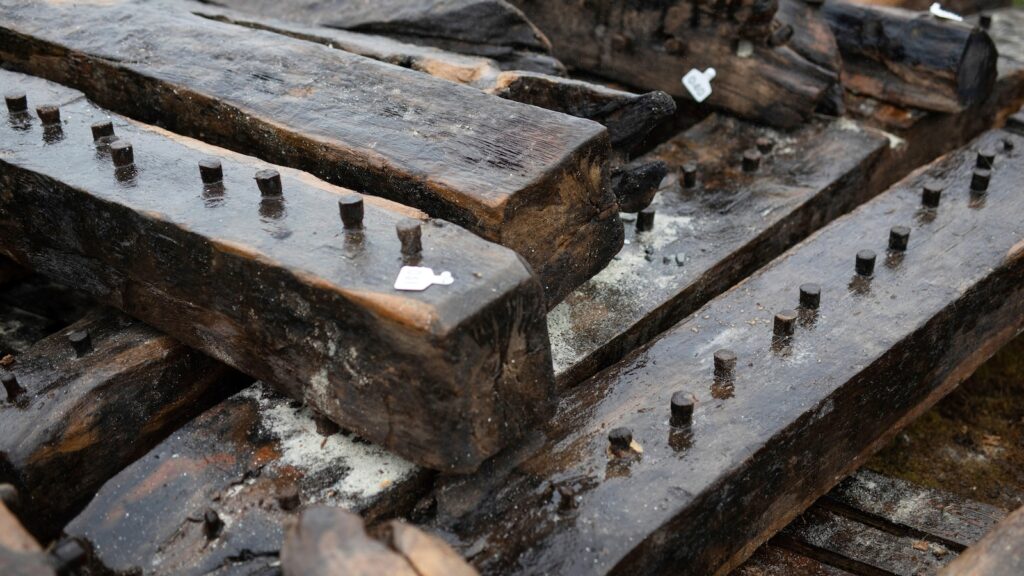LONDON — When a schoolboy going for a run discovered the ribs of a picket ship poking by means of the dunes of a distant Scottish seaside, it sparked a hunt by archaeologists, scientists and native historians to uncover its story.
Via a mixture of high-tech science and group analysis, they’ve a solution. Researchers introduced Wednesday that the vessel could be very seemingly the Earl of Chatham, an 18th-century warship that noticed motion within the American Conflict of Independence earlier than a second life looking whales within the Arctic — after which a stormy demise.
“I’d regard it as a fortunate ship, which is a wierd factor to say a few ship that’s wrecked,” stated Ben Saunders, senior marine archaeologist at Wessex Archaeology, a charity that helped group researchers conduct the investigation.
“I feel if it had been discovered in lots of different locations, it wouldn’t essentially have had that group drive, that want to recuperate and research that materials, and likewise the group spirit to do it,” Saunders stated.
The wreck was found in February 2024 after a storm swept away sand overlaying it on Sanday, one of many rugged Orkney Islands that lie off Scotland’s northern tip.
It excited curiosity on the island of 500 folks, whose historical past is certain up with the ocean and its risks. Round 270 shipwrecks have been recorded across the 20-square-mile (50-square-kilometer) island because the fifteenth century.
Native farmers used their tractors and trailers to haul the 12 tons of oak timbers off the seaside, earlier than native researchers set to work attempting to establish it.
“That was actually good enjoyable, and it was such a very good feeling in regards to the group – everyone pulling collectively to get it again,” stated Sylvia Thorne, one of many island’s group researchers. “Fairly just a few individuals are actually getting keen on it and turning into consultants.”
Dendrochronology — the science of courting wooden from tree rings — confirmed the timber got here from southern England in the course of the 18th century. That was one little bit of luck, Saunders stated, as a result of it coincides with “the purpose the place British paperwork’s actually beginning to kick off” and detailed data have been being saved.
“And so we are able to then begin to take a look at the archive proof that we’ve got for the wrecks in Orkney,” Saunders stated. “It turns into a means of elimination.
“You take away ones which are Northern European versus British, you take away wrecks which are too small or working out of the north of England and you actually are down to 2 or three … and Earl of Chatham is the final one left.”
Additional analysis discovered that earlier than it was the Earl of Chatham, the ship was HMS Hind, a 24-gun Royal Navy frigate inbuilt Chichester on England’s south coast in 1749.
Its army profession noticed it play an element within the enlargement — and contraction — of the British Empire. It helped Britain wrest management of Canada from France through the sieges of Louisbourg and Quebec within the 1750s, and within the 1770s served as a convoy escort throughout Britain’s failed effort to carry onto its American colonies.
Offered off by the navy in 1784 and renamed, the vessel grew to become a whaling ship, looking the massive mammals within the Arctic waters off Greenland.
Whale oil was a vital gasoline of the Industrial Revolution, used to lubricate equipment, soften cloth and light-weight metropolis streets. Saunders stated that in 1787 there have been 120 London-based whaling ships within the Greenland Sea, the Earl of Chatham amongst them.
A 12 months later, whereas heading out to the whaling floor, it was wrecked in dangerous climate off Sanday. All 56 crew members survived — extra proof, Saunders says, that this was a vessel blessed with luck.
The ship’s timbers are being preserved in a freshwater tank on the Sanday Heritage Centre whereas plans are mentioned to place it on everlasting show.
Saunders stated that the mission is a mannequin of group involvement in archaeology.
“The group have been so eager, have been so wanting to be concerned and to search out out issues to study, they usually’re so happy with it. It’s right down to them it was found, it’s right down to them it was recovered and it’s been stabilized and been protected,” he stated.
For locals, it’s a hyperlink to the island’s maritime previous — and future. Discovering long-buried wrecks might turn out to be extra widespread as local weather change alters the wind patterns round Britain and reshapes the shoreline.
“One of many greatest issues I’ve received out of this mission is realizing how a lot the previous in Sanday is simply consistently with you — both seen or simply underneath the floor,” stated Ruth Peace, one other group researcher.

